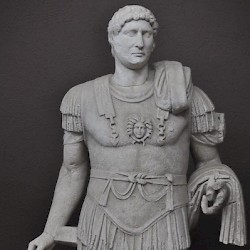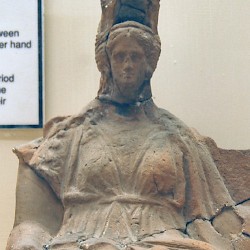Troy VIII-IX
Q22647Ilion or Troy: town in northwestern Asia Minor, famous for the legendary Trojan War, in which a coalition of Mycenaean warriors captured the city of king Priam.Homer's Iliad deals with an episode from this war.
Troy VIII

When Homer composed the Iliad, he could still see one or two temples, the walls, and the well house of Troy VI. It was sufficient to create a poem about a mighty city that had been destroyed.
It was also the beginning of Troy's second life: in the Archaic Age, the temples were in use again. One of these was situated directly to the west of the former citadel and may have been dedicated to Cybele, the Great Mother of the Gods; the second sanctuary may have been dedicated to Athena and may have stood in the center of the citadel. There is no direct proof for this temple at this moment, but it did certainly exist at a later time.

The sanctuary of Troy was not an independent city-state. In the seventh century, Athens and Mitylene fought for the possession of nearby Sigeion, and Troy is not mentioned. In the end, this war was won by the Athenians - in 560 BCE, to be precise - and we know that it became the place of refuge for the members of the Pisistrad clan, which had once ruled Athens, but had been expelled in 510. They recognized the suzereignty of the Persians, and we know that in 480, when the Achaemenid king Xerxes embarked upon a campaign against Greece, he sacrificed in the temple of Troy.note In 411, the Spartan commander Mindarus did the same.note
In 334, it was Alexander's turn to visit the place, and sacrifice (text). By the end of his reign, in 323, he had decided to build a new temple in Troy (text), a plan that was executed by his successors, Lysimachus, Seleucus I Nicator, and the Seleucid kings. The temple's cult statue was based in reports about what the Palladion must have looked like, the mysterious statue of Athena that had once fallen from the sky. This was the beginning of a whole new era, in which Troy became a city again: a decent, Greek city, with a Bouleterion (town hall), a mint, and a theater. It could accomodate about 8,000 people. At the same time, the ancient burial mounds were restored.

In c.250 BCE, the ancient wall of Troy VI was renovated again, but it was probably through diplomacy - and not actual fight at the wall - that Troy managed to survive the invasion of the Galatians, who were active in this area in 217. The town was now regularly visited by "tourists", like Seleucid king Antiochus III the Great in 192, and two years later Gaius Livius Salinator and Lucius Cornelius Scipio.note
It also survived the unquiet years after the end of the Pergamene Empire in 133 BCE. Yet it may have been a sign of the times that there were houses built within the walls, in the citadel. In the end, however, the city was sacked in the course of the First Mithridatic War by the Roman commander Gaius Flavius Fimbrianote This happened in 85 BCE, and although Roman leaders like Sulla and Caesar promised to restore Troy, the city appears to have been abandoned. A treaty from 77 shows that the Trojans needed help of their neighbors to celebrate games.
 Troy VIII, Head of Zeus |
 Troy VIII, Coin with the Trojan statue of Athena |
 Troy VIII, Metope |
 Troy VIII, Hellenistic Athena |
Troy IX

The Romans had already accepted the legendary Trojans as their ancestors in the fourth century, and in the third century, this was sufficiently well-known to be accepted in Alexandria. In the propaganda of Julius Caesar, it played a role as well: he not only claimed that Aeneas had come from Troy to Italy and had founded a city over there, but also claimed that Aeneas's son Ascanius had been surnamed Ilus ("boy from Ilion") and had been the ancestor of the Julius family. After the assassination of Caesar, his distant relative Octavian accepted it as well. After he and Mark Antony had defeated Caesar's assassins Brutus and Cassius in the Battle of Philippi (42 BCE), they repopulated Troy with veterans of the Sixteenth Legion.

In 20, Octavian, now called Augustus and first emperor of the Roman Empire, visited Troy, and ordered repairs. An odeon was built on the site of the old bouleuterion, and from now on, the city was a major center of ancient tourism. Its coins, for example, commemorated the Trojan War, and the tie to Roman was stressed by a representation of the Lupercal in Troy's theater. Yet, there were more economical activities: we know, for instance, that natural stone was quarried near Koç Ali, and exported to nearby towns.
The emperor Hadrian visited the city in 124. He appears to have ordered new repairs and may have redecorated the odeon, where his statue has been found. His visit marks the beginning of a golden age, with the construction of Roman baths, a fountain (nymphaeum), and an aqueduct. Substantial parts of it survive and can be seen near Kemerdere.
The next emperor to visit the place was Caracalla in 214; during his stay, he killed his favorite Festus, who was buried in ancient style, and received a funeral mound similar to Achilles and Ajax. He also ordered repairs to the odeon.
In 267, the Goths pilaged the country, but in the fourth century, Troy recovered for the last time, perhaps sponsored by Constantantine the Great (r.306-337), who contemplated to move the empire's capital to Troy before he decided to build Constantinople. Several authors present the city as still alive,note but an earthquake in c.500 meant the end of its prosperity.
 Troy IX, Hadrian |
 Troy IX, Figurine of Cybele |
 Troy IX, Julio-Claudian lady |
 Troy IX, Silvanus |